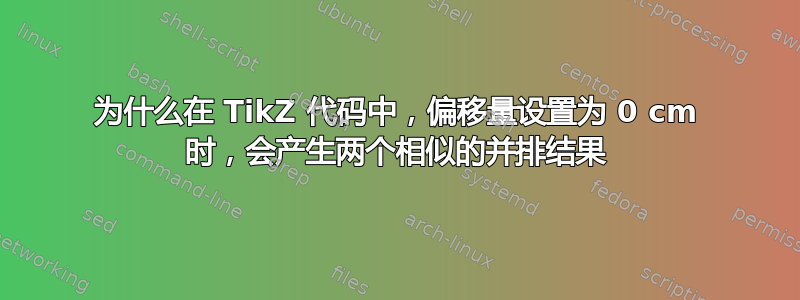
在下面的代码中
\documentclass[10pt]{article}
\usepackage{tikz}
\usetikzlibrary{intersections}
\begin{document}
\begin{tikzpicture}
\clip (-0.5,-0.75) rectangle (3.25,2.25);
\foreach \pathname/\shift in {line/0cm, curve/2cm}{ \tikzset{xshift=\shift}
\draw [->, name path=curve] (1,1.5) .. controls (-1,1) and (2,0.5) .. (0,0);
\draw [->, name path=line](0,-.5) -- (1,2) ; \fill [name intersections={of=line and curve,sort by=\pathname, name=i}] [red, opacity=0.5, every node/.style={left=.25cm, black, opacity=1}] \foreach \s in {1,2,3} {(i-\s) circle (2pt) node {\footnotesize\s}};
}
\end{tikzpicture}
\end{document}
这里假设\pathname line偏移量设置为 0cm,但为什么会显示这个结果呢?
而且我也有点困惑这部分代码到底是什么意思
\foreach \pathname/\shift in {line/0cm, curve/2cm}{ \tikzset{xshift=\shift}
\draw [->, name path=curve] (1,1.5) .. controls (-1,1) and (2,0.5) .. (0,0);
\draw [->, name path=line](0,-.5) -- (1,2) ; \fill [name intersections={of=line and curve,sort by=\pathname, name=i}] [red, opacity=0.5, every node/.style={left=.25cm, black, opacity=1}] \foreach \s in {1,2,3} {(i-\s) circle (2pt) node {\footnotesize\s}};
}
答案1
这是选项文档下的示例/tikz/intersection/sort by=<path name>这是PGF 手册中
没有任何\foreach,左侧可以绘制为
\begin{tikzpicture}
\draw[->, name path=curve] (1,1.5) .. controls (-1,1) and (2,0.5) .. (0,0);
\draw[->, name path=line] (0,-.5) -- (1,2);
\fill
[name intersections={of=line and curve, sort by=line, name=i}]
[red, opacity=0.5, every node/.style={left=.25cm, black, opacity=1}]
(i-1) circle (2pt) node {\footnotesize1}
(i-2) circle (2pt) node {\footnotesize2}
(i-3) circle (2pt) node {\footnotesize3};
\end{tikzpicture}
使用内部\foreach,circle可以绘制三个
\fill[name intersections={..., name=i}] [...]
\foreach \s in {1,2,3}
{ (i-\s) circle (2pt) node {\footnotesize\s} };
为了展示选项 的效果sort by,此示例需要展示sort by=line和如何sort by=curve影响交叉点的编号。这引出了右侧。为了将两个图形并排放置,使用了以下结构:
% left side
\tikzset{xshift=0cm} % useless
\draw[..., name path=curve] ...
\draw[..., name path=line ] ...
\fill[name intersections{..., sort by =line}] ...
% right side
\tikzset{xshift=2cm} % shift every following drawings to right by 2cm
\draw[..., name path=curve] ...
\draw[..., name path=line ] ...
\fill[name intersections{..., sort by =curve}] ...
左右两侧的相似性导致了外部的\foreach。
答案2
foreach 循环的语法允许对多个变量进行迭代。这里,循环对名为\pathname和 的两个变量进行迭代\shift。后一个变量定义了通过 向右的水平移动\tikzset{xshift=\shift}。
循环中选择的名称{line/0cm, curve/2cm}实际上与路径名无关 name path=curve,name path=line如下面的示例所示,我修改了这些名称:{lin/0cm, cur/1cm, lol/2cm}
\documentclass[10pt]{article}
\usepackage{tikz}
\usetikzlibrary{intersections}
\begin{document}
\begin{tikzpicture}
%\clip (-0.5,-0.75) rectangle (3.25,2.25);
\foreach \pathname/\shift in {bin/0cm, cur/1cm, lol/2cm, gag/3cm}{ \tikzset{xshift=\shift}
\draw [->, name path=curve] (1,1.5) .. controls (-1,1) and (2,0.5) .. (0,0);
\draw [->, name path=line](0,-.5) -- (1,2) ;
\fill [name intersections={of=line and curve,%sort by=\pathname,
name=i}] [red, opacity=0.5, every node/.style={left=.25cm, black, opacity=1}]
\foreach \s in {1,2,3} {(i-\s) circle (2pt) node {\footnotesize\s}};
}
\end{tikzpicture}
\end{document}



